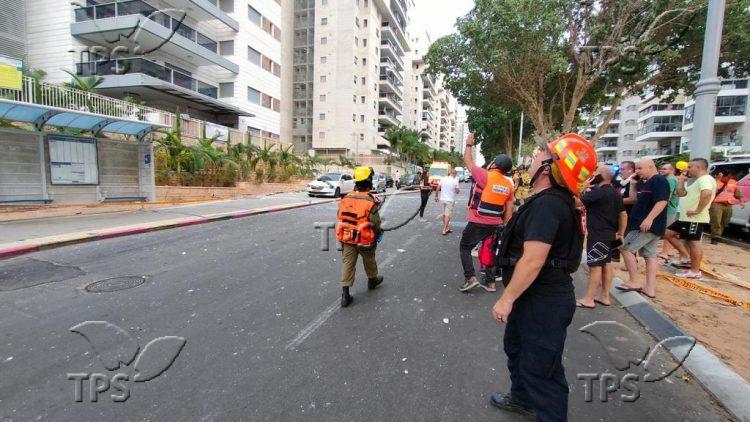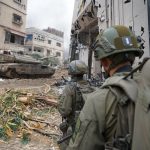As War Presses On, Israeli Evacuees In No Hurry to Return
Jerusalem, 28 January, 2024 (TPS) -- One hundred and fourteen days into Israel’s war against Hamas, rocket sirens continue to sound in evacuated southern Israel towns as fierce fighting continues in Hamas’s southern Gaza stronghold of Khan Younis.
While some of the 217,000 Israelis evacuated from 105 communities in the north and south of Israel since Oct. 7, 2023 have started returning to their homes, most still live in temporary accommodations largely subsidized by the state.
About 4,000 evacuees have returned to Ashkelon, at which Hamas has fired 1,380 rockets since Oct. 7. Nearly 200 hit the city, impacting 487 sites. While rocket-fire from the Strip has fallen dramatically since the start of the war, according to Ashkelon mayor Tomer Glam much more is needed.
“On Oct. 7, we took a huge hit. The goal is now to completely eliminate Hamas and Jihad Islamic. After 110 days of war, we can’t yet picture the end,” said Glam at the Israeli Defense and Security Forum (IDSF) in Ashkelon on Thursday.
Although life is almost completely back to normal in Ashkelon, with over 90% of the education system operational, Glam told the Tazpit Press Service that there are still security gaps to be addressed.
“We work in full coordination with the defense establishment and the government of Israel. We sometimes have differences of opinion but we continue to work symbiotically for the residents of Israel to benefit from full security,” he said.
“We must destroy all terror groups that threaten the lives of innocents. If not, massacres like Oct. 7 may happen again,” he added.
In Sderot, some 30,000 residents were evacuated and most have yet to return, as Sderot’s mayor Alon Davidi earlier this month rejected the Israeli government’s offer to begin resettling the population starting Feb. 4.
“If we don’t persist in this war and defeat our enemy, it will send the message that the state of Israel kneels in front of monsters…. We must do more,” said Davidi at the IDSF.
In response to Hamas’s Oct. 7 massacre, the IDF on Oct. 27 launched a ground operation in the Gaza Strip, with the stated goals of destroying the terrorist group as a military and political entity in the enclave.
“The IDF destroyed Hamas’s terror infrastructure in the northern part of Gaza. Our forces are now attacking and systematically destroying Hamas’s capabilities in Khan Younis while moving above ground and underground to reach Hamas’s leadership and release the hostages,” IDF Brig. Gen. (res.) Amir Avivi, the founder and chairman of IDSF, told TPS.
The terror group massacred 1,200 people on Oct. 7, and wounded thousands more. It also kidnapped more than 240 people. Of these, 110 have been freed so far, while 136 are believed to still be in Gaza.
According to Avivi, while the IDF has made steady progress against Hamas, more remains to be done.
“In the central part of Gaza, Israeli forces managed to destroy a few positions but have not yet seized full control. The IDF is also currently not in control of Rafah City. Without full control, it is impossible to cut off Hamas logistically,” he added.
It is now believed that the Islamist group built between 350 and 450 miles of subterranean terror infrastructure in Gaza, of which the IDF has damaged or rendered inoperable 20% to 40%, according to The Wall Street Journal, citing Israeli and U.S. officials.
Last month, the Israeli military began construction on an approximately half-mile-wide buffer zone along the entire 37-mile Gaza border, according to Hebrew media. The buffer is located on the Gaza side of the border, and only IDF personnel will be allowed to enter.
However, the buffer zone is more of a tactical than a strategic security measure, according to Avivi.
“Beyond a buffer zone, to ensure the security of residents of the south, Israel must control the border between Gaza and Egypt and what goes in. This also means long-term complete freedom of operation inside Gaza, like in Judea and Samaria,” he said.
“The IDF must be able to operate every day, everywhere, in every city and every town to apprehend terrorist cells building capabilities,” he explained.
IDF Brig. Gen. (res.) Yosef Kuperwasser, senior research fellow at the Jerusalem Center for Public Affairs and at Misgav institute, told TPS that a buffer zone is still essential to prevent future infiltrations.
“We are establishing a perimeter in which we will be deployed so that no one will be able to cross over and conduct another massacre. It might not prevent Hamas from launching rockets but it will make it much more difficult for them to penetrate Israel either above ground or underground in the way they did on Oct. 7,” Kuperwasser told TPS.
“Defeating Hamas in Gaza remains the most effective way to ensure the safe return of the residents of the south to their towns and villages,” he added.
According to analysts, along with defeating Hamas, maintaining military control inside Gaza remains the only valid option in creating better conditions for the return of Israel’s southern residents to their homes.







